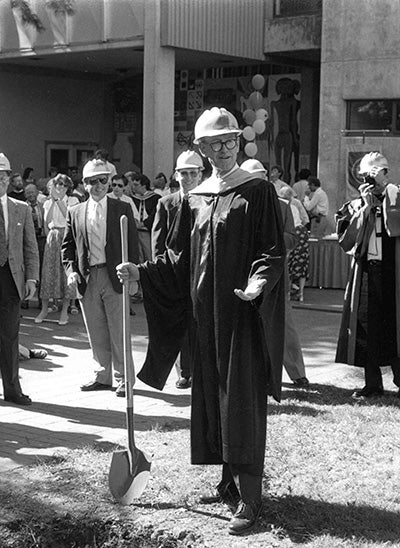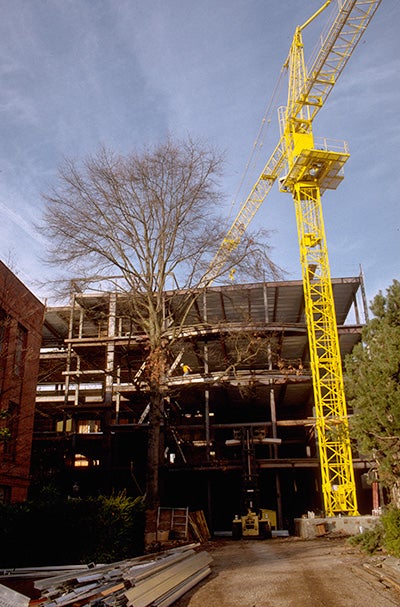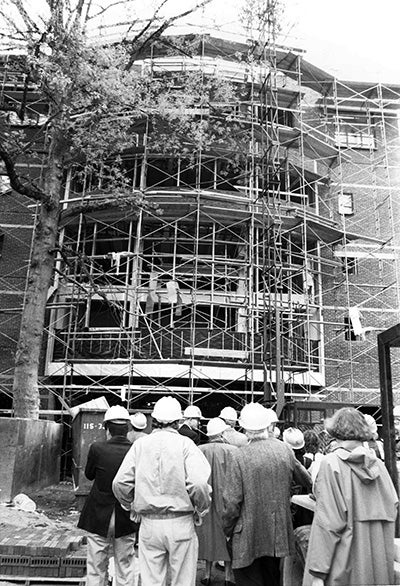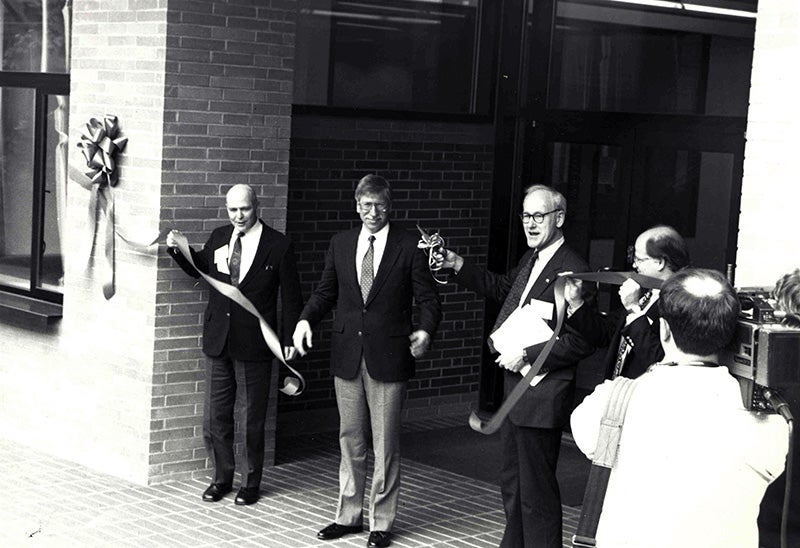In the fall of 1987, the Oregon Legislature approved $8.03 million for a long-awaited “Architecture and Allied Arts Addition and Alteration” project at UO. The move marked the fulfillment of a twenty-two year commitment to expand the school that began in 1965.
The project was direly needed, as Wilmot “Bill” Gilland, then dean of the school, said during the dedication of the project after it was completed, in 1991:
To give you some idea of what this change means, let me just recount my own experience in studio locations during the past twenty-two years. When I first came to Oregon I had a studio on the second floor of the old Boiler Plant adjacent to the then woodshop, so conversations were often impossible and tables were blessed with sawdust. [Later] I had a studio on the North Site on the second floor of the old Farmhouse, where the roof leaked and it was so cold that students had to wear gloves while drawing.

Above: Students, faculty, and staff listen as the new A&AA building project is officially dedicated in 1991.
It was a long journey to these new facilities in 1991. In 1965, the Oregon Legislature had approved 89,620 net square feet of new building space for A&AA, but only 39,800 was funded, as a story in the Fall 1987 A&AA Review noted. The 1987 appropriation of more than $8 million meant an additional 24,000 square feet along with “significant remodeling” of spaces in Lawrence Hall and fine art studios and the interior architecture woodshop at the Millrace/Northsite complex. The project also moved and expanded the A&AA Library, added studio and seminar spaces, faculty and GTF offices, research and lab spaces, and, as the 1987 Review explained, would add “a school ‘hearth’ to serve as a focus of student activity.”
One of the main goals of the project was to “consolidate the school’s activities into three ‘home sites.’ ” These were Lawrence Hall, Hendricks Hall, “and the North Art site” on the Millrace. “Currently the School’s 127,000 square feet of space is spread over numerous sites in 27 different structures,” the 1987 Review pointed out.
The design process for the expansion was itself an Oregon invention, following “the user participation model outlined in Christopher Alexander’s Oregon Experiment,” the Review noted, “with the first of a series of pattern language workshops” in late October 1987. The workshops, which went through fall and winter terms, gathered “input and reactions from all interested students and faculty.”

Above: Dean Wilmot (Bill) Gilland breaks ground in 1989 on the new four-story addition to Lawrence Hall as Board of Visitors members in hardhats look on.
Construction began in winter 1989. Gilland’s comments at the dedication of the new Lawrence Hall facilities in 1991 noted that, along with the changes in Lawrence Hall, new A&AA spaces also occupied land between the Millrace, the railroad tracks, and the Willamette River:
These sites are imbued with flow and movement and related to the early settlement of Eugene and its commerce. It is here that we are more free to make things—to build— and to experiment, which is so much part of our nature. It is here that we will have … fine arts programs including ceramics, which on occasion uses the very clay from the banks of the Willamette in its firings.
The Fall 1990 Review celebrated Lawrence Hall’s “new brick facade and south court facing 13th Avenue and University Street …[as] a “real ‘front door.’ ” The Review also heralded the “new LaVerne Krause Art Gallery [and] the second floor stairhall where a generous crossroads acts as forecourt to the library, review rooms, the computer graphics center, Pacific Hall studios, and the W.R. B. Willcox Hearth—soon to be occupied by the coffee bar.”
The Hearth was named for Willcox, head of the architecture program from 1922 until his death in 1947. Willcox had established a tradition of opening his home once a week to students of the school for informal discussions, a tradition the Hearth brought conveniently into Lawrence Hall itself five days a week.
One of the most visible benefits of the building project was the great bay window of the Library’s new reading room. The Marion Ross Reading Room was named for Ross, a professor of art history who headed the Department of Art History for fifteen years. Ross died one month prior to the dedication of the new building; its reading room was already scheduled to bear his name.
At the dedication, Elisabeth Walton Potter, then president of the A&AA Board of Visitors, noted that Ross was the “champion” of the A&AA Library and “a legend as builder of the Department of Art History. He endowed [the A&AA Library] with contributions from his personal collections and treasure. The Marion Ross Reading Room will be used not only by students and returning alumni but by visiting scholars and the public at large,” Potter said.
The new expansion offered other firsts as well. For the first time in thirty-five years, all design studios were located “in one contiguous location” in Lawrence and Pacific halls. But budget restraints prevented details such as furniture, because the school “opted for adequately scaled, but unfinished, space rather than an undersized, but fully finished, project. ... We are counting on fundraising campaigns for the various named spaces to help us complete the project.”
Also still incomplete in Fall 1990 were “the two major projects north of the Millrace” scheduled to be finished March 1991. These included the Wood Shop and Millrace III, the latter of which housed photography on the first floor and, on the second floor, graduate painting studios with skylights, 30-foot tall ceilings, and 12 X 8 foot windows. The North Site when completed also housed a furniture design studio, construction technology lab, the Urban Farm, and the Ceramics Barn for kilns.
In his remarks at the dedication of the new space, Gilland suggested the project
will serve as a catalyst for continued improvements. … Ultimately, the environment in which artists and designers learn should be a model or demonstration of both beautiful and supportive places where the space we inhabit inspires and facilitates our activity. This is why we need to continue our efforts and not think that the work is done, today.


Above left: The frame for the new southern entrance to Lawrence Hall under construction. Above right: Members of the A&AA Board of Visitors, in hardhats, visit the construction project as scaffolding outlines where the new A&AA Library will be.

Above: Dean Bill Gilland (with scissors in hand) cuts the ribbon to the expanded Lawrence Hall as UO President Myles Brand (on Gilland’s right), OUS Chancellor Thomas Bartlett (far left), and Stan Boles of BOORA Architects (far right) assist.

Above: The completion of the “Addition and Alterations” project in 1991 traded twenty-seven sites for four, centralizing school activities that had taken place in Emerald Hall, Agate Street Houses, Condon School, and the Science Annex info four consolidated sites: Hendricks Hall, Lawrence Hall, Pacific Hall, and the North Art Site. Shown here is the new four-story, south-facing addition to Lawrence Hall after it opened.
